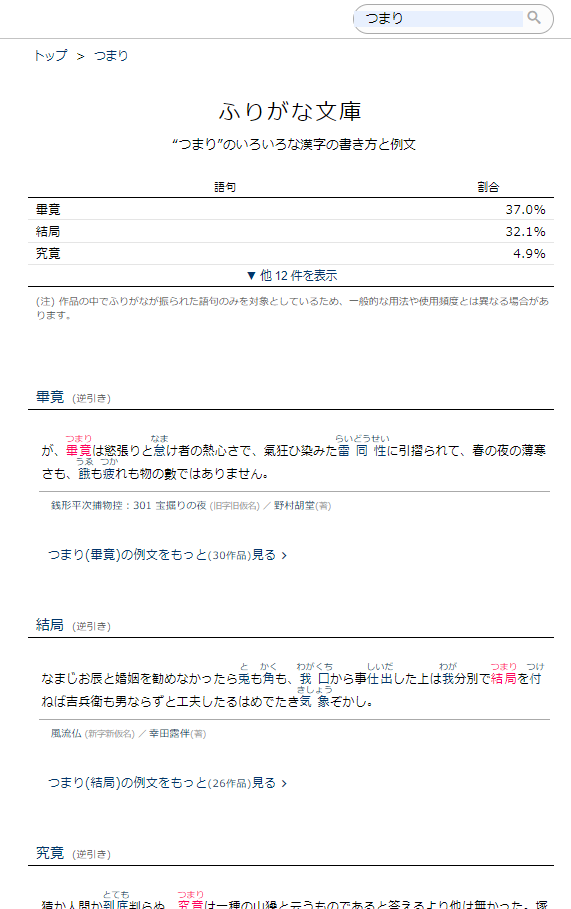Furigana Bunko is a tool to find out how to read kanji and to find examples of kanji used from the furigana.
You can also look up different readings for vocabulary written in kanji.
- You can search for vocabulary that uses kanji from furigana used in Aozora Bunko texts (introductory articles).
- There are many different kanji that use the same furigana.
- Search the furigana for kanji used in Aozora Bunko.There are many different furigana (readings) for the same kanji.
- You can see characteristics of kanji readings that authors who appear in Aozora Bunko prefer.
- You can see many examples used in actual novels.
How to...
When you read novels written in the Meiji and early Showa periods, you will find that many words that are written in hiragana today used to be written in kanji.
For example, Natsume Soseki wrote the word はっきり (hakkiri, meaning clearly) using the kanji 判然, 判切, or 明瞭.
Furigana Bunko is a useful tool when you want to look up kanji readings or kanji with the same reading.
It could come in handy when you're reading old archives and reference material.
Looking up the reading (furigana) from the kanji
First let's find out how to read kanji.
What readings are there for the kanji 夫?
Of course it's read おっと (otto) and ふ (fu), but do you know any other readings?
Write 夫 in the search box.
The search shows それ (sore), そ (so), and おっと (otto) as examples.
Click 他42件を表示 (see 42 more) to see many more examples.
The list shows furigana use in Aozora Bunko by order of frequency.
ふ (fu) was number 12.
Evidently, おっと (otto) can also be read おつと (otsuto).
At the bottom of the list are sentences using the three most frequently used words.
Click 例文をもっと見る (see more sentences) for each reading, to see more examples.
If you click ▼すべて表示 (show all) at the end to show examples using other words.
Let's take a look at 夫 (それ sore).
There are examples by Fukuzawa Yukichi and Natsume Soseki, too.
Looking up kanji from the reading (furigana)
Now let's look and see what kind of kanji are used for the same readings (furigana).
First, you can go back to the page that shows readings and sample sentences to find words with the same readings.
Let's take a look at sentences using different readings for 夫 .
Click where it says それ(逆引き)(sore, back search).
Now we see kanji that can be read それ (sore).
It looks like there are 108 examples, including 夫, 其, and 某.
Of course you can also look it up by entering the reading (furigana) in the search box at the top right of the homepage.
For example, if you search the reading つまり (tsumari), you will see examples like 畢竟, 結局, and 究竟.
Texts from the Meiji to early Showa periods are often written differently from the standard writing today, with writers expecting 平生 , 例, or 平常 to be read いつも (itsumo) and 例 to be read ためし (tameshi), れい (rei), or いつも (itsumo).
At times like this, it is a useful tool for looking up readings and increasing your kanji vocabulary.
If you're struggling with older manuscripts, why don't you give it a try?










